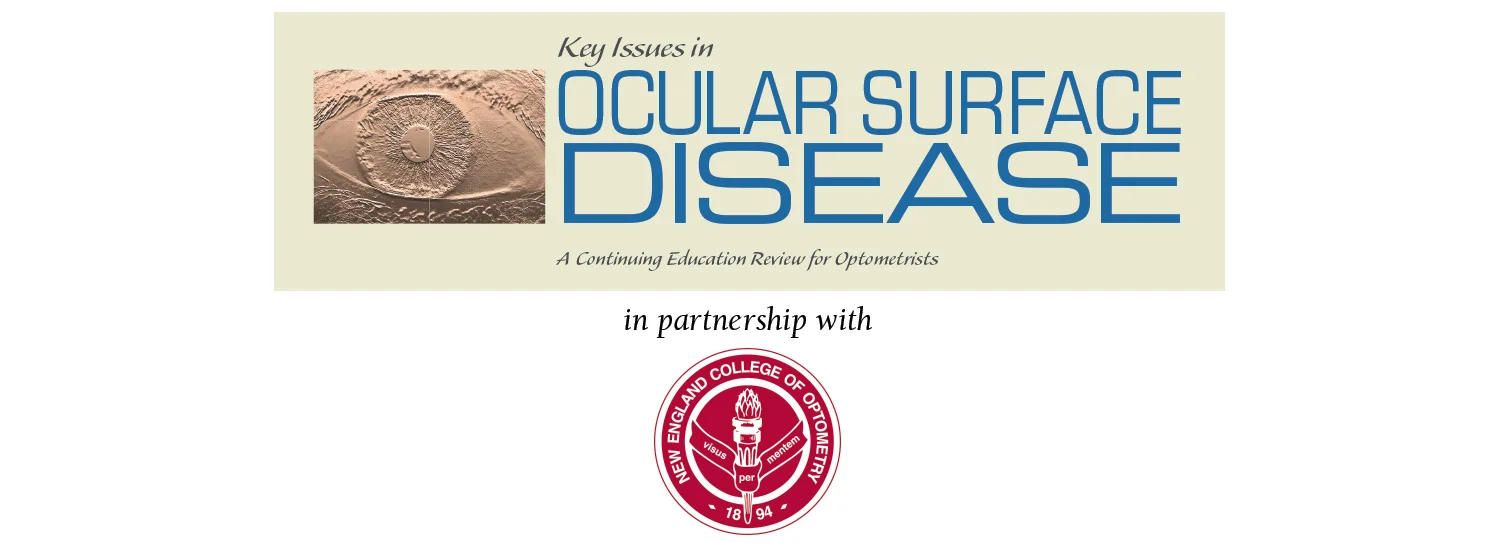Needs Assessment
Although sometimes used as a synonym for dry eye disease, the term “ocular surface disease” refers to a cluster of anterior eye disorders that includes dry eye (evaporative or due to tear insufficiency), bacterial and viral infections, blepharitis, meibomian gland dysfunction, allergic conjunctivitis, ocular surface problems associated with glaucoma treatment, and the ocular manifestation of systemic inflammatory diseases and endocrine disorders (eg, Sjögren’s syndrome, arthritis, and thyroid disease).
While prevalence data vary considerably based on the population studied and disease definition, all of these conditions are common.1-3 In addition, they share pathogenic mechanisms, have overlapping clinical signs and symptoms, and are often comorbid.4 For example, allergic conjunctivitis, blepharitis and Sjögren’s syndrome—like dry eye disease—are inflammatory conditions that affect the ocular surface and share a number of symptoms, including discomfort, itching, dryness, and irritation.5,6
Diagnosis and treatment of ocular surface disease are clearly important, but they are rendered difficult by a number of factors: the frequency of comorbid conditions with similar signs and symptoms; incomplete understanding of the underlying pathogenesis; frequently poor correlation between signs and symptoms; occasional systemic disease as an underlying factor, and the absence of simple, clear diagnostic tests. Even after diagnosis, adherence to best practice in patient management is complicated by the number of agents available and competing claims for them in the marketplace.
Each installment of Key Issues in Ocular Surface Disease will look at two important topics in the management of ocular surface disease in order to support optometrists’ clinical reasoning and decision-making abilities and navigate the growing body of sometimes contradictory evidence on ocular surface disease. The benefits are substantial: accurate diagnosis and effective treatment of ocular surface disease will contribute greatly to patient comfort and satisfaction, help patients enjoy comfortable contact lens wear, and significantly enhance outcomes in cataract and corneal refractive surgery.
References
- O’Brien PD, Collum LM. Dry eye: diagnosis and current treatment strategies. Curr Allergy Asthma Rep. 2004;4:314-19.
- Lin PY, Tsai SY, Cheng CY, et al. Prevalence of dry eye among an elderly Chinese population in Taiwan: The Shihpai eye study. Ophthalmology. 2003;110:1096-1101.
- McCarty CA, Bansal AK, Livingston PM, et al. The epidemiology of dry eye in Melbourne, Australia. Ophthalmology. 1998;105:1114-19.
- Hom MM, Nguyen AL, Bielory L. Allergic conjunctivitis and dry eye syndrome. Ann Allergy Asthma Immunol. 2012;108(3):163-6.
- Berdy GJ, Hedqvist B. Ocular allergic disorders and dry eye disease: associations, diagnostic dilemmas, and management. Acta Ophthalmol Scand Suppl. 2000; 230:32-37.
- Grayzel AI: What is Sjogren’s? Chapter 2 in The Sjogrens Book. Fourth Edition, Ed DJ Wallace. Oxford University Press, New York, 2012. pp 7-10.
Off-Label Use Statement: This work may discuss off-label uses of medications.
Accreditation Statement: This activity has been planned and implemented through the joint sponsorship of New England College of Optometry and Candeo Clinical/Science Communications, LLC. New England College of Optometry is accredited by The Council on Optometric Practitioner Education® (COPE®), created by the Association of Regulatory Boards of Optometry (ARBO) to accredit continuing education on behalf of optometric licensing boards.
Credit Designation Statement: This Distance Learning CE course is sponsored by New England College of Optometry and is supported by an unrestricted educational grant from Shire. For that reason, there is no registration fee to participate. After reading the issue, candidates must complete the online post-course test to verify learning and qualify for 1 hour/unit of COPE-Accredited CE. A printable certificate of completion is generated for participants who successfully pass the post-course test with a score of 70% or higher. The instructional time is a minimum of 50 minutes. IMPORTANT NOTE: Distance Learning/Multimedia courses do not qualify as CEE Courses. Only live lectures qualify as CEE courses.

